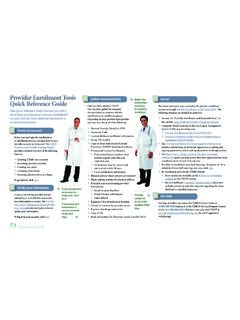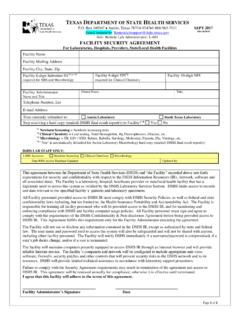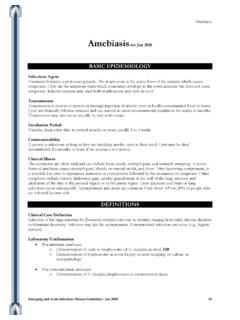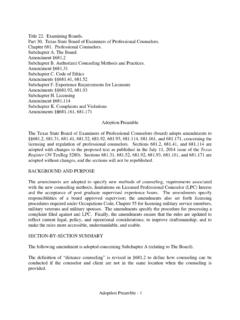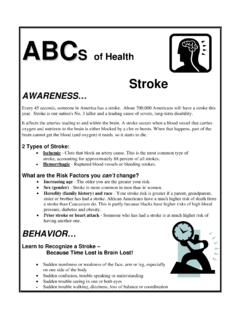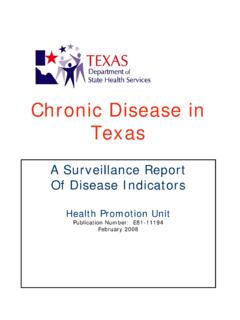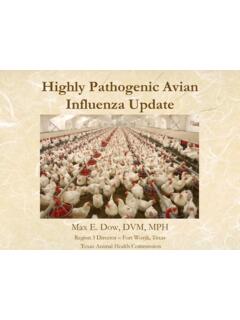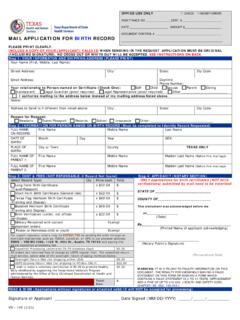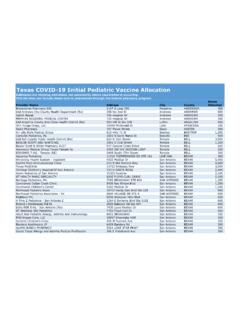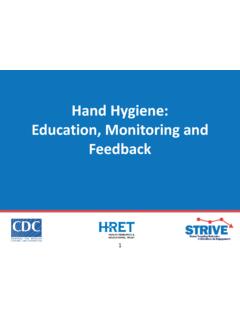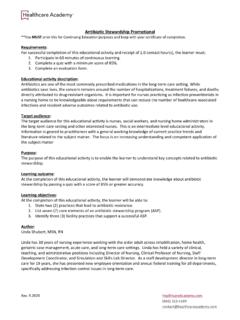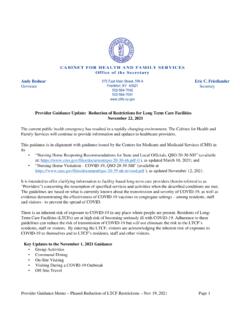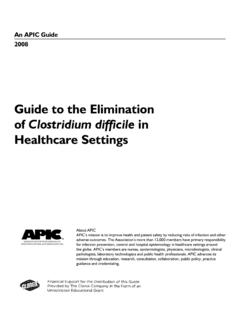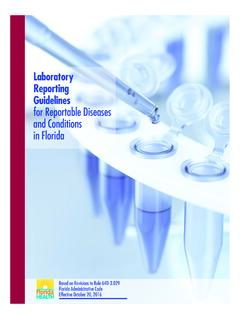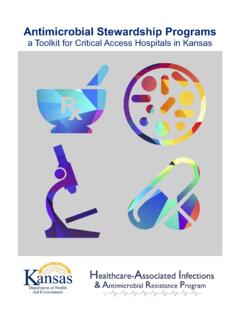Transcription of INFECTION PREVENTIONIST RESOURCE TOOLKIT - Texas
1 1 | P a g e INFECTION PREVENTIONIST RESOURCE TOOLKIT Many materials end up creating an INFECTION Preventionists (IP) RESOURCE toolbox. Depending on the responsibilities of the IP, the following materials may or may not be applicable to the job. INFECTION prevention and control covers many aspects of healthcare. Included in this document are a To-Do checklist and lists of organizations, websites and documents that should be helpful to any IP. TO-DO CHECKLIST There is no template for where to begin on day one as a new IP. The needs of your facility, the state of the program, and the amount of man-hours dedicated to the program will all influence what pulls your immediate attention. Below is a checklist that an IP should try to tackle within their first month in office . CLOSE OUT PENDING ITEMS FROM ANY RECENT SURVEY FINDINGS THAT MAY NEED TO BE RESOLVED (STATE, CMS, OR ACCREDITATION SURVEY). REVIEW REQUIRED ANNUAL DOCUMENTS: INFECTION Prevention Plan Findings from surveys can be used to fine tune your plan for the facility.
2 Use control charts for each type of HAI or NHSN-required reportable condition to track where the facility stands and plan interventions based on data analysis. Plan should include: o Demographics of community served o General facility information such as number of beds and average monthly census and/or length of stay o Specific prioritized INFECTION prevention goals for the current year and interventions that will be undertaken to achieve those goals. Should always include: Monitoring for occurrence of infections (house-wide and targeted surveillance) Outbreak investigation Policy and procedure review and revision 2 | P a g e Staff education related to INFECTION prevention Quality assurance Consultation a RESOURCE to physicians, staff, administrators and patients o Division of responsibilities for INFECTION prevention activities o Reporting Reports to INFECTION Prevention Committee Reports to INFECTION Prevention supervisor and others as directed Providing feedback to staff Reporting to NHSN, DSHS TxHSN and public health as required for notifiable conditions INFECTION Control Risk Assessment and Prioritized Goals should be formally reviewed at least annually and whenever significant changes occur in the elements that affect risk.
3 Should include: o Risks from geographical location and community environment o Potential device-associated infections o Surgical site infections o Specific MDROs MRSA, VRE, MDR-A, ESBLs, CREs, etc. o Specific infections Influenza, novel influenza ( , avian influenza, swine influenza) Legionella or Tuberculosis Anything prevalent in the community that may show up at the facility o Prioritized goals based on risk score in descending order Identify strategies to mitigate these risks REVIEW PAST INFECTION PREVENTION COMMITTEE MINUTES (NAME OF COMMITTEE MAY VARY) REVIEW ADDITIONAL ITEMS THAT WERE MONITORED BY THE DEPARTMENT/PROGRAM BUT NOT REPORTED IN THE MINUTES 3 | P a g e BECOME FAMILIAR WITH POLICIES, CREATE TIMELINE FOR ANY THAT ARE OUTDATED OR NEED UPDATING. o Review references in policies and make sure they are up-to-date. VERIFY REQUIREMENTS AND REPORTING STATUS FOR NHSN AND TXHSN AND HAVE FACILITY ADMINISTRATOR UPDATE THE CONTACT INFORMATION o Obtaining access to NHSN may take a while so make sure to do this as soon as possible.
4 O For assistance with TxHSN, email LEARN THE SYSTEM FOR CAPTURING AND RECORDING YOUR SURVEILLANCE infections , REPORTABLE DISEASES AND COLONIZATION TOUR THE FACILITY AND DO A SHORT SURVEY, INCLUDING THE STAFF AND MANAGEMENT, RELATED TO INFECTION PREVENTION POLICY, PROCEDURE, AND PRACTICES AND CREATE A LIST OF ITEMS THAT SHOULD BE ADDRESSED o Some examples of the survey would include: Cleanliness: Floor to ceiling, in patient vs. non-patient care areas, sterile vs. non-sterile Location and number of negative air pressure rooms Are PPE and hand hygiene products readily available? Is the facility using current best practices for reducing infections ? What disinfectants are currently used at the facility? o Begin communication with Housekeeping, Facilities and Pharmacy staff Some of their functions and expertise will assist you in your duties 4 | P a g e IF YOU ARE NEW TO INFECTION PREVENTION, THE FOLLOWING RESOURCES WILL HELP YOU GET STARTED: Read and keep the guidelines from the CDC on Hand Hygiene, Isolation Precautions and Environmental Control.
5 Read the other guidelines by the CDC/HICPAC as time permits. Contact your local APIC chapter and attend the meetings, if one is available. ORGANIZATIONS, WEBSITES, AND RESOURCES Most of the organizations mentioned in this document are non-regulatory. However, regulatory and accrediting bodies will often use these organizations guidelines or recommendations as standards. The list below is in order of usefulness to an IP, though this may be subjective to the reader. Regulatory and accrediting agencies have been noted with an asterisk. Though some of the documents listed below may overlap, rarely do they have conflicting viewpoints. Not all documents published by an organization have been listed, but the ones provided are a good starting point for a new IP. Items listed under Guidelines and Resources are ones that an IP should be familiar with and know where to locate the information. As a new IP, it would be considered an interminable task to try and memorize these documents in their entirety at the beginning of your career.
6 Rather, consider keeping these handy resources in a binder or in the bookmark section of your internet browsing toolbar. 5 | P a g e ASSOCIATION FOR PROFESSIONALS IN INFECTION CONTROL AND EPIDEMIOLOGY (APIC) APIC is the leading professional association for IPs. APIC works with other professional organizations, consumer groups, regulatory and accrediting bodies to produce recommendations and guidelines related to INFECTION prevention and control. Website: Guidelines and Resources: o Practice Resources: o Monthly Scientific Journal: o APIC Text: o Local Chapters: o Risk Assessment Template: Scroll down to IC Risk Assessment Documents for templates. CERTIFICATION BOARD OF INFECTION CONTROL AND EPIDEMIOLOGY (CBIC) CBIC is the leading provider of professional certification for INFECTION prevention and control. Certification by CBIC is the standard of excellence that INFECTION Prevention and Control professionals will seek in order to ensure the delivery of quality care that the public expects, demands, and deserves.
7 Website: Online Initial Certification Application: 6 | P a g e CDC - CENTERS FOR DISEASE CONTROL AND PREVENTION CDC s mission is to collaborate to create the expertise, information, and tools that people and communities need to protect their health. Website: Guidelines and Resources: o Health Care Associated infections : o Morbidity and Mortality Weekly Report (MMWR): Recommended Resources INFECTION Control in Health Care Personnel, 1998 Preventing the Transmission of Mycobacterium tuberculosis in Health-care Settings, 2005 Emergency Water Supply Planning Guide for Hospitals and Health Care Facilities, 2011 Guidance for Control of Carbapenem-resistant Enterobacteriaceae (CRE) TOOLKIT , 2015 Pink book (Vaccination Guidance) 2012 CDC S NATIONAL HEALTHCARE SAFETY NETWORK (NHSN) NHSN is the nation s most widely used healthcare-associated INFECTION (HAI) tracking system. It also has the capabilities to track additional items such as blood safety errors, healthcare personnel influenza vaccine status, and INFECTION control adherence, to name a few.
8 Website: Guidelines and Resources: o Select your Facility Type from the link above, next select a focus area. o Each focus will have CDC/NHSN/HICPAC resources listed. 7 | P a g e HEALTHCARE INFECTION CONTROL PRACTICES ADVISORY COMMITTEE (HICPAC) HICPAC is a federal advisory committee that provides advice and guidance to the CDC and the Secretary of the Department of Health and Human Services regarding the practice of INFECTION control and strategies for surveillance, prevention, and control of healthcare-associated infections , antimicrobial resistance and related events in healthcare settings. Website: Guidelines and Resources: Guidelines for Hand Hygiene in Healthcare Settings, 2002 Guidelines for Environmental Control in Healthcare Facilities, 2003 Preventing Healthcare-Associated Pneumonia, 2003 Management of Multidrug-Resistant Organisms, 2006 Isolation Precautions: Preventing Transmission of Infectious Agents, Appendix A, 2007 Guidelines for Disinfection and Sterilization in Healthcare Facilities, 2008 Prevention of Catheter-associated Urinary Tract infections , 2009 Prevention of Intravascular Catheter-Related infections , 2011 Prevention and Control of Norovirus Gastroenteritis Outbreaks, 2011 8 | P a g e THE SOCIETY FOR HEALTHCARE EPIDEMIOLOGY OF AMERICA (SHEA) SHEA is an organization that works to define best practices in healthcare epidemiology and aims to prevent and control healthcare-associated infections .
9 Website: Guidelines and Resources: o Professional Resources: o Patient Education Guides: o Monthly Scientific Journal: THE JOINT COMMISSION (COMMONLY REFERRED TO AS TJC)* The Joint Commission is an independent, not-for-profit organization, which accredits and certifies care organizations and programs. Accreditation is sometimes a prerequisite for facilities to receive reimbursement or to fulfill state requirements. Pronounced JAY-co though the organization prefers to be called Joint Commission. Website: Guidelines and Resources: o INFECTION Prevention and Control Section: o National Patient Safety Goals: 9 | P a g e Texas DEPARTMENT OF STATE HEALTH SERVICES (DSHS) INFECTIOUS DISEASE CONTROL UNIT (IDCU)* The Infectious Disease Control Unit (IDCU) is responsible for assisting local or regional public health officials in investigating outbreaks of acute infectious disease or isolated cases of rare or unusual disease. The Unit is comprised of two branches, The Emerging & Acute Infectious Disease Branch (EAIDB) and the Zoonosis Control Branch (ZCB).
10 The EAIDB oversees a variety of different conditions, specifically the notifiable conditions in TX. Under the EAIDB is the Healthcare Safety Group (HCS group) which oversees healthcare-associated infections (HAIs) and reporting requirements for the State, as well as outbreak responses across the continuum of care. Within the HCS group there are two specific teams: the HAI audit team and the HAI investigation team. The HAI audit team works with NHSN and TxHSN data and healthcare reporting and audit validation. The HAI investigation team is comprised of regional HAI epidemiologist that work with healthcare facilities on a variety of different tasks and are a great RESOURCE for new IPs. (Find out who your regional HAI Epi is for your health service region). While the EAIDB is not a regulatory branch, the DSHS Health Facility Program which oversees facility licensing is and the two work together. Website: Guidelines and Resources o Health Care-Associated infections and Reporting Requirements: o TxHSN viewable, facility reported HAI data: o Notifiable Conditions State Requirement: o Health Facility Program: Note: If you are a general hospital, the Texas Administrative Code 25 Title 25, Part 1, Chapter 133, Subchapter C, Rule g.
